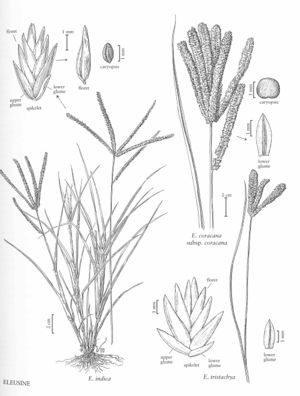Difference between revisions of "Eleusine tristachya"
FNA>Volume Importer |
FNA>Volume Importer |
||
| Line 17: | Line 17: | ||
-->{{Treatment/Body | -->{{Treatment/Body | ||
|distribution=Tex.;N.J.;Va.;Mo.;Ala.;Oreg.;N.Y.;Calif.;Nev. | |distribution=Tex.;N.J.;Va.;Mo.;Ala.;Oreg.;N.Y.;Calif.;Nev. | ||
| − | |discussion=<p>In the 1800s and early 1900s, Eleusine tristachya was found on ballast dumps at various ports and trans¬portation centers in the United States. It has since been found as a weed in the Imperial Valley of California (Hilu 1980), but records of collections outside of California appear to be historical, with no populations persisting. The species was originally thought to be native to tropical Africa and introduced into tropical America, but it occurs in Africa only as a rare adventive. It is now considered to be native to tropical America.</p> | + | |discussion=<p>In the 1800s and early 1900s, <i>Eleusine tristachya</i> was found on ballast dumps at various ports and trans¬portation centers in the United States. It has since been found as a weed in the Imperial Valley of California (Hilu 1980), but records of collections outside of California appear to be historical, with no populations persisting. The species was originally thought to be native to tropical Africa and introduced into tropical America, but it occurs in Africa only as a rare adventive. It is now considered to be native to tropical America.</p> |
|tables= | |tables= | ||
|references= | |references= | ||
| Line 26: | Line 26: | ||
-->{{#Taxon: | -->{{#Taxon: | ||
name=Eleusine tristachya | name=Eleusine tristachya | ||
| − | |||
|authority=(Lam.) Lam. | |authority=(Lam.) Lam. | ||
|rank=species | |rank=species | ||
| Line 33: | Line 32: | ||
|basionyms= | |basionyms= | ||
|family=Poaceae | |family=Poaceae | ||
| − | |illustrator=Linda A. Vorobik | + | |illustrator=Linda A. Vorobik;Karen Klitz |
| + | |illustration copyright=Utah State University | ||
|distribution=Tex.;N.J.;Va.;Mo.;Ala.;Oreg.;N.Y.;Calif.;Nev. | |distribution=Tex.;N.J.;Va.;Mo.;Ala.;Oreg.;N.Y.;Calif.;Nev. | ||
|reference=None | |reference=None | ||
| Line 39: | Line 39: | ||
|publication year= | |publication year= | ||
|special status= | |special status= | ||
| − | |source xml=https:// | + | |source xml=https://jpend@bitbucket.org/aafc-mbb/fna-data-curation.git/src/f50eec43f223ca0e34566be0b046453a0960e173/coarse_grained_fna_xml/V25/V25_179.xml |
|subfamily=Poaceae subfam. Chloridoideae | |subfamily=Poaceae subfam. Chloridoideae | ||
|tribe=Poaceae tribe Cynodonteae | |tribe=Poaceae tribe Cynodonteae | ||
Revision as of 20:36, 16 December 2019
Plants annual. Culms 10-45 cm, compressed. Blades 6-25 cm long. Panicles digitate, with (1)2-3 branches; branches 1-6(8) cm long, 5-14 mm wide, oblong. Spikelets 8-10 mm, with 5-9(11) florets. Glumes unequal; lower glumes 2-3 mm; upper glumes 3-4 mm; lemmas 4-5 mm. 2n = 18.
Distribution
Tex., N.J., Va., Mo., Ala., Oreg., N.Y., Calif., Nev.
Discussion
In the 1800s and early 1900s, Eleusine tristachya was found on ballast dumps at various ports and trans¬portation centers in the United States. It has since been found as a weed in the Imperial Valley of California (Hilu 1980), but records of collections outside of California appear to be historical, with no populations persisting. The species was originally thought to be native to tropical Africa and introduced into tropical America, but it occurs in Africa only as a rare adventive. It is now considered to be native to tropical America.
Selected References
None.
